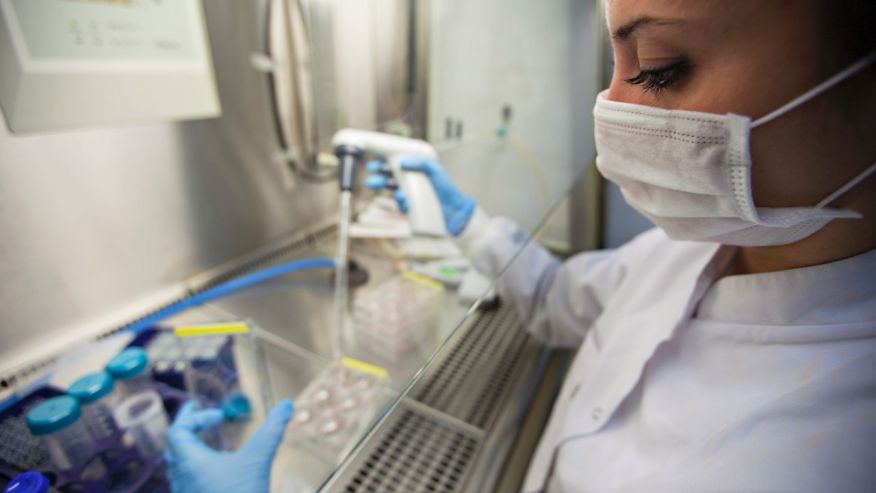Simple blood test diagnoses Parkinson’s disease

A new research report appearing in the December issue of the FASEB Journal (http://www.fasebj.org) shows how scientists from the United Kingdom have developed a simple blood test to detect Parkinson’s disease even at the earliest stages. The test is possible because scientists found a substance in the blood, called “phosphorylated alpha-synuclein,” which is common in people with Parkinson’s disease, and then developed a way to identify its presence in our blood.
“A blood test for Parkinson’s disease would mean you could find out if a person was in danger of getting the disease, before the symptoms started,” said David Allsop, Ph.D., a researcher involved in the work from the Division of Biomedical and Life Sciences and the School of Health and Medicine at the University of Lancaster, in Lancaster, UK. “This would help the development of medicines that could protect the brain, which would be better for the quality of life and future health of older people.”
To develop the blood test for Parkinson’s disease, Allsop and colleagues studied a group of people diagnosed with the disease and a second group of healthy people of a similar age. Blood samples from each group were analyzed to determine the levels of phosphorylated alpha-synuclein present. They found those with Parkinson’s disease had increased levels of the substance. Based upon these findings, researchers developed a blood test that detects the presence of phosphorylated alpha-synuclein, which could allow for diagnosis of the disease well before symptoms appear but when brain damage has already begun to occur.
“When most people think of Parkinson’s disease, they think of the outward symptoms, such as involuntary movements,” said Gerald Weissmann, M.D., Editor-in-Chief of the FASEB Journal, “but many people with Parkinson’s also develop neurological problems that may be more difficult to detect right away. Having a blood test not only helps doctors rule out other possible causes of the outward symptoms, but it also allows for early detection which can help patients and their caregivers prepare for the possibility of the mental, emotional, and behavioral problems that the disease can cause.”
Source: http://www.eurekalert.org












 1. Behind-the-Head Lat Pulldowns
1. Behind-the-Head Lat Pulldowns The Alternative: You can still work your lats without the risk of behind-the-head pulldowns by pulling the bar down in front of you. Sit with your spine straight, abs pulled in, and then lean your torso back slightly, keeping your spine straight. Pull the bar down towards your chest, but not below your collar bone.
The Alternative: You can still work your lats without the risk of behind-the-head pulldowns by pulling the bar down in front of you. Sit with your spine straight, abs pulled in, and then lean your torso back slightly, keeping your spine straight. Pull the bar down towards your chest, but not below your collar bone. 2. Squats or Leg Presses with Deep Knee Bends
2. Squats or Leg Presses with Deep Knee Bends The Alternatives: Squats and leg presses are generally safe and effective when done properly. But you should never bend your knees or hips more than 90 degrees during these exercises. Here’s an example of proper form when doing a leg press machine, but this can apply to squats with a barbell, and the sled machine, too.
The Alternatives: Squats and leg presses are generally safe and effective when done properly. But you should never bend your knees or hips more than 90 degrees during these exercises. Here’s an example of proper form when doing a leg press machine, but this can apply to squats with a barbell, and the sled machine, too. 3. Seated Leg Extensions
3. Seated Leg Extensions The Alternatives: Simple
The Alternatives: Simple  4. Inner and Outer Thigh Machine Exercises
4. Inner and Outer Thigh Machine Exercises The Alternatives: The best way to target these muscles safely is with body weight exercises, such as standing adduction, standing abduction, lying adduction and
The Alternatives: The best way to target these muscles safely is with body weight exercises, such as standing adduction, standing abduction, lying adduction and  5. Upright Rows
5. Upright Rows The Alternatives: Instead of standing to perform an upright row, try bent-over rows, bending forward 90 degrees at the hip, holding weight down beneath your shoulders with hands slightly more than shoulder width apart, then lift weight straight up towards your chest until elbows and shoulders form a straight line. You can also try front or
The Alternatives: Instead of standing to perform an upright row, try bent-over rows, bending forward 90 degrees at the hip, holding weight down beneath your shoulders with hands slightly more than shoulder width apart, then lift weight straight up towards your chest until elbows and shoulders form a straight line. You can also try front or 
 A 5-year-old Long Island girl is credited with saving her mother’s life.
A 5-year-old Long Island girl is credited with saving her mother’s life. The number one selling sunscreen in the U.S. natural markets, W.S. Badger Company, has voluntarily recalled 30,000 of its baby and kids’ sunscreen lotions because of potential disease-causing bacteria.
The number one selling sunscreen in the U.S. natural markets, W.S. Badger Company, has voluntarily recalled 30,000 of its baby and kids’ sunscreen lotions because of potential disease-causing bacteria. I
I